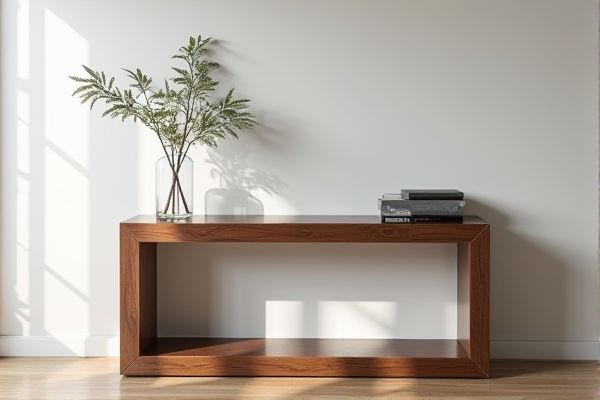
Glass console tables offer a sleek, modern aesthetic with a light, airy feel that can make a room appear more spacious, while wood console tables provide warmth, durability, and a timeless, classic look that adds character and sturdiness to any space. Discover which console table best suits Your style and functional needs by reading the rest of the article.
Table of Comparison
| Feature | Glass Console Table | Wood Console Table |
|---|---|---|
| Material | Tempered or regular glass with metal or wooden frame | Solid wood or engineered wood (oak, pine, walnut) |
| Durability | Moderate; prone to scratches and breakage | High; resistant to daily wear and long-lasting |
| Maintenance | Requires frequent cleaning to avoid smudges and fingerprints | Easy maintenance; occasional polishing recommended |
| Weight | Lightweight and easy to move | Heavier and more stable |
| Style | Modern, sleek, and minimalist | Classic, rustic, or traditional |
| Cost | Generally higher due to glass materials and craftsmanship | Varies; often more affordable with budget-friendly options |
| Safety | Fragile; potential hazard in homes with children/pets | Safer; solid construction reduces breakage risk |
| Transparency | Transparent surface enhances visual space | Opaque; adds warmth and texture |
Introduction to Console Tables
Console tables enhance your living space by offering both style and functionality, with glass and wood as popular material choices. Glass console tables provide a sleek, modern look with a light, airy feel that can make small spaces appear larger by reflecting light. Wood console tables offer durability and warmth, showcasing natural grains that bring a timeless, classic charm to any room.
Aesthetic Appeal: Glass vs. Wood
Glass console tables offer a sleek, modern aesthetic with their transparent surfaces that create an open, airy feel, perfect for contemporary interiors. Wood console tables provide a warm, timeless charm, showcasing natural grains and textures that add character and coziness to any space. Your choice between glass and wood will significantly influence the room's ambiance, balancing between minimalist elegance and classic warmth.
Durability and Maintenance
Glass console tables typically offer moderate durability, as tempered glass resists scratches and heat but can be prone to chipping or cracking under heavy impact. Wood console tables provide superior durability, especially when made from hardwoods like oak, walnut, or maple, which resist wear and can be refinished to restore their appearance. Maintenance for glass tables involves regular cleaning with glass cleaners to avoid smudges, while wood tables require periodic polishing or oiling to protect the finish and maintain moisture balance.
Versatility in Home Decor
Glass console tables offer a sleek, modern aesthetic that seamlessly integrates with minimalist, contemporary, and even eclectic home decor styles due to their transparent and reflective surfaces. Wood console tables provide warmth and texture, complementing traditional, rustic, and farmhouse interiors with their rich grains and natural finishes. Both materials enhance versatility by serving as functional focal points, but glass tables create an illusion of space while wood pieces add tactile depth.
Space and Light Reflection
Glass console tables enhance space perception and maximize light reflection, creating an airy and open ambiance in any room. Wood console tables provide a solid, grounded appearance but may absorb light, making a space feel cozier yet less luminous. Choosing between glass and wood affects the room's brightness and spatial openness, influencing both aesthetic appeal and functional lighting.
Customization and Design Options
Glass console tables offer sleek, modern designs with versatile customization options such as tinted, frosted, or textured glass, enhancing light reflection and openness in your space. Wood console tables provide rich, natural textures and finishes, allowing for intricate carvings, stains, and paint options that complement traditional or rustic aesthetics. Your choice depends on whether you prioritize the contemporary elegance of glass or the warm, customizable character of wood.
Price Comparison: Glass vs. Wood
Glass console tables typically range from $150 to $600, offering sleek, modern aesthetics with higher price points for tempered or designer glass. Wood console tables vary widely in price, generally between $100 and $1,200, depending on wood type, craftsmanship, and finish, with hardwood options like oak or walnut commanding premium prices. Budget-conscious buyers often find affordable wood tables, while glass options tend to be pricier due to material and manufacturing factors.
Safety Considerations
Glass console tables require tempered or safety glass to reduce the risk of shattering and injury, making them less suitable for homes with children or pets. Wood console tables offer superior durability and stability, minimizing the risk of tipping or breakage under heavy weight or impact. Choosing the appropriate material depends on balancing aesthetic preferences with household safety needs and usage patterns.
Environmental Impact
Glass console tables often have a lower environmental impact due to their recyclability and the use of fewer natural resources compared to wood. Wood console tables may contribute to deforestation and require energy-intensive processing, but sustainably sourced wood offers a renewable option. Your choice impacts resource conservation and waste generation, so consider materials certified by environmental standards when selecting a console table.
Choosing the Right Console Table for Your Space
Glass console tables offer a sleek, modern look that maximizes light and creates an airy feel, making them ideal for small or contemporary spaces. Wood console tables provide warmth, durability, and timeless appeal, suited for traditional or rustic interiors requiring sturdy furniture. Your choice depends on desired aesthetics, room size, and maintenance preferences to enhance both functionality and style.
 homyna.com
homyna.com